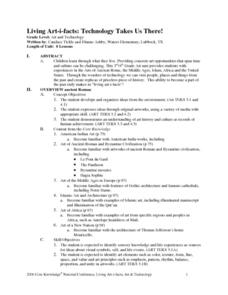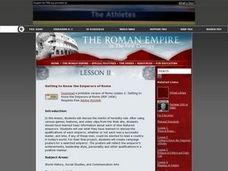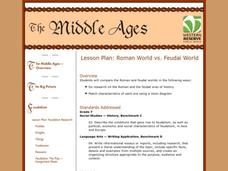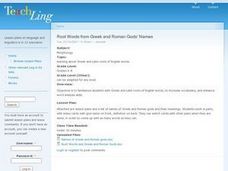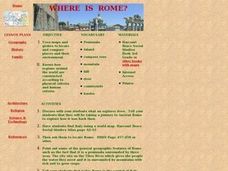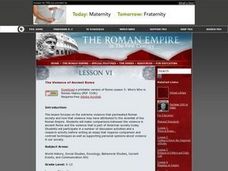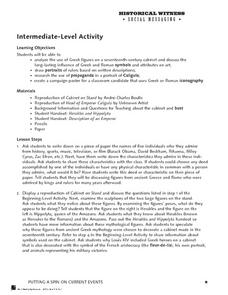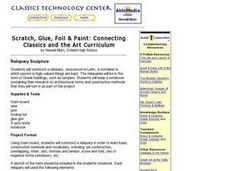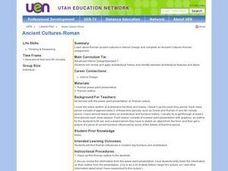Curated OER
Living Art-i-facts: Technology Takes Us There!
Students create living artifacts dealing with different times and cultures. They explore Ancient Rome, the Middle Ages, Islam, Africa, and the United States.
Curated OER
English Words from Greek and Roman Names of Gods
Hydra/hygiene, Muse/music. Many English words are built on roots derived from the names of Greek and Roman gods. After examining a list of Greek and Roman gods and the meaning of their names, class members find the root in a list...
Curated OER
Who's Who in Roman History
Students, in groups, produce a classroom documentary about important historical figures from the Roman Empire. They create posters to be part of a classroom timeline showing when each of these people lived and their impact on the empire.
Curated OER
The Alphabet is Historic: The Roman Alphabet is our Alphabet
Students show that the Greeks, Phoenicians and Romans lived in the Mediterranean area. They give reasons why the alphabet was important for the Romans. and say that the Romans developed the alphabet they are learning in school.
Curated OER
Ancient Roman Monuments and Timeline
While a terrific idea, this lesson in which learners create a timeline showing the date that a variety of buildings and monuments were built in Ancient Rome, requires resources teachers may not have. It requires the use of a Smartboard,...
Curated OER
Ancient Rome
Students complete pre reading, writing, during reading, and interdisciplinary activities for the book Ancient Rome. In this reading lesson plan, students complete journal entries, go over vocabulary, answer short answer questions, have...
Curated OER
The Rise of Christianity in the Roman Empire
Ninth graders investigate the growth of Christianity in Rome. In this Roman Empire activity, 9th graders listen to a SMART Board lecture about the Jesus, Christianity, and the empire prior to composing thematic essays about the spread of...
Curated OER
Aqueduct Architecture: Moving Water to the Masses in Ancient Rome
Ninth graders compare ancient and modern technology in water transporting. In this lesson on the evolution of the aqueduct, 9th graders build a working aqueduct model and examine its components. They explain the importance and use of the...
Curated OER
Vocabulary of Ancient Rome Grades 9-12)
Students define ancient Roman vocabulary using the dictionary writing sentences.
Curated OER
A Day in the Life: Studying Ancient Rome
Class members use their knowledge of Ancient Rome to write articles for an online newspaper. Using WebBlender, learners craft articles that feature Roman politics, culture, and leisure activities.
Curated OER
Romans in Britain, or Classical Colonialism
Students identify the extent of the Roman Empire on a map of Europe and North Africa. They discuss the reasons behind Roman expansion and occupation. They read Cymbeline and write about the attitudes of 3 characters. Groups stage the scene.
Curated OER
Mythological Word Origins
Review myths and the characters therein, connecting them to vocabulary words in the English language today. Begin by searching online for myths and character names. With at least ten names that are familiar English words, young scholars...
Curated OER
Getting to Know the Emperors of Rome
Heredity rule? Absolute power? Class members access Internet sites, view videos, and engage in a educational game to examine the achievements and leadership style of nine Roman emperors. Individuals then select one of these figures, and...
Northeastern Educational Television of Ohio, Inc.
Roman World vs. Feudal World
Young historians compare the major features of the Roman and feudal worlds, such as religion, social hierarchy, and political tenets, using online resources and group discussion.
Curated OER
Bronze Bow
Explore ancient Rome through reading The Bronze Bow by Elizabeth George Speare. Readers activate prior knowledge by examining objects that relate to the story and predict the significance of the items. Their curiosity is aroused...
Curated OER
Root Words from Greek and Roman Gods' Names
Prepare a stack of index cards with a Greek or Roman god's name on one side and their description on the other. Then, use the worksheet attached to brainstorm as many words that contain the root from each card. Pupils also create their...
Curated OER
Where Is Rome?
Third graders discover Ancient Rome through maps and worksheets. In this world history activity, 3rd graders locate Rome on a world map and identify the scope of the Roman Empire. Students label an entire map of Italy after...
Curated OER
The Violence of Ancient Rome
Students compare the violence in ancient Rome and the violence in American society today. They research and write an essay that requires comparison and contrast techniques as well as supporting personal opinions about violence in our...
Curated OER
Greek and Roman Symbolism
Students explore Greek and Roman symbolism in art. In this visual art instructional activity, students draw portraits of ancient leaders based on the written descriptions they read about them. Students also design campaign posters using...
Curated OER
Scratch, Glue, Foil & Paint: Connecting Classics and the Art Curriculum
High schoolers construct a reliquary using foam board, researching basic Greek and Roman architecture and basic construction methods. They record their research and information in an architectural journal.
Curated OER
Animals in Ancient Rome (Grades 7-8)
Students explore the role of animals in ancient Rome through the interpretation of a fictional account.
Curated OER
Vocabulary of Ancient Rome (Grades 6-8)
Students define ancient Roman vocabulary using the dictionary writing sentences. They write sentences for each word that use the words in their original and contemporary contexts.
Curated OER
Ancient Cultures - Roman
Learners examine the Ancient Roman culture focusing on how they decorated their homes. As a class, they watch a PowerPoint presentation and complete an outline. Individually, they draw their own sketch of a Roman chair using...
Curated OER
This Was the Noblest Roman of Them All
High schoolers analyze the problems with staging and character using the play Julius Caesar. They summarize the final scene of the play and view film versions of the scene. Additionally, they prepare a promptbook for the final scene and...
